Episcopal polity
An episcopal polity is a hierarchical form of church governance ("ecclesiastical polity") in which the chief local authorities are called bishops. (The word "bishop" derives, via the British Latin and Vulgar Latin term *ebiscopus/*biscopus, from the Ancient Greek ἐπίσκοπος epískopos meaning "overseer".) It is the structure used by many of the major Christian Churches and denominations, such as the Catholic, Eastern Orthodox, Oriental Orthodox, Church of the East, Anglican, and Lutheran churches or denominations, and other churches founded independently from these lineages.
| Ecclesiastical polity |
|---|
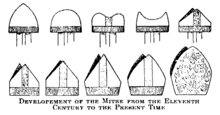
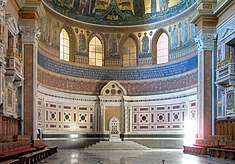
Churches with an episcopal polity are governed by bishops, practicing their authorities in the dioceses and conferences or synods. Their leadership is both sacramental and constitutional; as well as performing ordinations, confirmations, and consecrations, the bishop supervises the clergy within a local jurisdiction and is the representative both to secular structures and within the hierarchy of the church. Bishops are considered to derive their authority from an unbroken, personal apostolic succession from the Twelve Apostles of Jesus. Bishops with such authority are said to represent the historical episcopate or historic episcopate. Churches with this type of government usually believe that the Church requires episcopal government as described in the New Testament (see 1 Timothy 3 and 2 Timothy 1). In some systems, bishops may be subject to bishops holding a higher office (variously called archbishops, metropolitans, or patriarchs, depending upon the tradition). They also meet in councils or synods. These gatherings, subject to presidency by higher ranking bishops, usually make important decisions, though the synod or council may also be purely advisory.
For much of the written history of institutional Christianity, episcopal government was the only known form of church organization. This changed at the Reformation. Many Protestant churches are now organized by either congregational or presbyterian church polities, both descended from the writings of John Calvin, a Protestant reformer working and writing independently following the break with the Catholic Church precipitated by The Ninety-Five Theses of Martin Luther.
Overview of episcopal churches
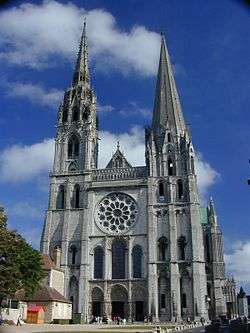
The definition of the word episcopal has variation among Christian traditions. There are subtle differences in governmental principles among episcopal churches at the present time. To some extent the separation of episcopal churches can be traced to these differences in ecclesiology, that is, their theological understanding of church and church governance. For some, "episcopal churches" are churches that use a hierarchy of bishops that regard themselves as being in an unbroken, personal apostolic succession.
"Episcopal" is also commonly used to distinguish between the various organizational structures of denominations. For instance, "Presbyterian" (Greek: 'πρεσβύτης, presbútēs) is used to describe a church governed by a hierarchy of assemblies of elected elders, referred to as Presbyterian polity. Similarly, "episcopal" is used to describe a church governed by bishops. Self-governed local congregations, governed neither by elders nor bishops, are usually described as "congregational".
More specifically, the capitalized appellation "Episcopal" is applied to several churches historically based within Anglicanism ("Episcopalianism"), including those still in communion with the Church of England.
Using these definitions, examples of specific episcopal churches include:
- The Catholic Church
- The Eastern Orthodox Church
- The Oriental Orthodox churches
- The Assyrian Church of the East
- The Churches of the Anglican Communion
- The Old Catholic churches
- Numerous smaller "catholic" churches
- Certain national churches of the Lutheran confession
- The African Methodist Episcopal Church
- The United Methodist Church
Some Lutheran churches practice congregational polity or a form of presbyterian polity.[1] Others, including the Church of Sweden, practice episcopal polity; the Church of Sweden also counts its bishops among the historic episcopate as do some American Lutheran churches like the Anglo-Lutheran Catholic Church, Lutheran Orthodox Church, Lutheran Church - International, and the Lutheran Episcopal Communion.
Many Methodist churches (see The United Methodist Church, among others) retain the form and function of episcopal polity, although in a modified form, called connexionalism. Since all trace their ordinations to an Anglican priest, John Wesley, it is generally considered that their bishops do not share in apostolic succession, though United Methodists still affirm that their bishops share in the historic episcopate.
Before the Great Schism
| Part of a series on the |
| Catholic Church |
|---|
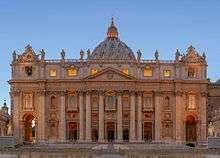 |
| Overview |
|
Miscellaneous
Relations with: |
|
|
All orthodox Christians were in churches with an episcopal government, that is, one Church under local bishops and regional Patriarchs. Writing between ca. 85 and 110, St. Ignatius of Antioch, Patriarch of Antioch, was the earliest of the Church fathers to define the importance of episcopal government. Assuming Ignatius' view was the Apostolic teaching and practice, the line of succession was unbroken and passed through the four ancient Patriarchal sees (those local churches known to be founded by apostles), Rome, Jerusalem, Antioch and Alexandria. Rome was the leading Patriarchate of the ancient four by virtue of its founding by Saints Peter and Paul and their martyrdom there, not to mention being the political center of the Roman empire at the time. Some organizations (e.g. the Assyrian Church of the East), though aloof from the political wranglings of imperial Christianity, nevertheless also practiced episcopal polity.
Shortly after the Roman Emperor Constantine I legalized Christianity in 321, he also constructed an elaborate second capital of the Roman Empire located at Byzantium and renamed it Constantinople, in 324. The single Roman Empire was divided between these two autonomous administrative centers, Roman and Constantinopolitan, West and East, Latin speaking and Greek speaking. This remained the status quo through the fourth century. A deep chasm developed between the East and West, becoming critical around 350, known as the Arian, or Nicene controversy. The Eastern Christian Churches were thought by Constantine to believe against the Trinity; that Christ was lesser than God. Hilary, Bishop of Poitiers, France, believed that the Eastern Church should be given the opportunity to, at least, be educated on the subject. Constantine, in his wisdom, and upset by disagreement, banished Hilary to the East. Hilary perfected his Greek language skills while in exile, and determined the great divide between Rome and the East was actually not a disagreement at all, and was merely a linguistic ignorance on the part of his Latin speaking contemporaries. This truth became known in the West, though some differences lingered. Hilary of Poitiers later became St. Hilary, Doctor of the Church, for exposing the true Christian beliefs of the Eastern Church. Many of Hilary's writings were lost to time.
In the fifth century, Pope Dioscorus, the Patriarch of Alexandria, rejected certain Christological dogmas promulgated by the Council of Chalcedon, and as a result, the Oriental Orthodox churches split from the rest; however they continued the episcopal tradition, and today in fact there is dialog between the various orthodox churches over whether the schism was due to real differences or simply translation failures.
Also during the fifth century, the Western Roman Empire declined and was overrun by German and Frankish peoples. Although the city of Rome was in ruins, distant from the seat of secular power, and constantly harassed by invaders, the Roman Patriarchate remained the center of the Western or Latin Church. Claiming the ancient primacy of Peter and the title of "Apostolic See", it remained the last court of episcopal appeal in serious matters for the whole Church, East and West. However, the center of the civilized Roman world had shifted definitively to Constantinople, or New Rome, the capital of the Greek speaking Empire. Along with this shift, the effective administration of the Church in the Eastern Roman Empire also shifted. This practical eminence of Constantinople in the East is evident, first at the First Council of Constantinople 381, and then ecumenically at the Council of Chalcedon in 451.
Beginning with John the Faster (John IV, 582-595), the Bishop of Constantinople adopted as a formal title for himself the by then customary honorific Ecumenical Patriarch ("pre-eminent father for the civilized world") over the strong objections of Rome, a title based on the political prestige of Constantinople and its economic and cultural centrality in the Empire. In the following years, Rome's appeals to the East were based on the unique authority of the Apostolic See and the primacy of Peter, over the powers of councils as defended by the East (councils, for example, had endorsed that lofty title which Rome contested).
The sometimes subtle differences between Eastern and Western conceptions of authority and its exercise produced a gradually widening rift between the Churches which continued with some occasional relief throughout the following centuries until the final rupture of the Great Schism (marked by two dates: 16 July 1054 and the Council of Florence in 1439).
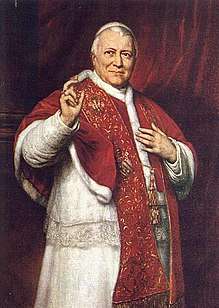
Catholic Church
The Catholic Church has an episcopate, with the Pope, who is the Bishop of Rome, at the top. The Catholic Church considers that juridical oversight over the Church is not a power that derives from human beings, but strictly from the authority of Christ, which was given to his twelve apostles. The See of Rome, as the unbroken line of apostolic authority descending from St. Peter (the "prince and head of the apostles"), is a visible sign and instrument of communion among the college of bishops and therefore also of the local churches around the world. In communion with the worldwide college of bishops, the Pope has all legitimate juridical and teaching authority over the whole Church. This authority given by Christ to St. Peter and the apostles is transmitted from one generation to the next by the power of the Holy Spirit, through the laying on of hands from the Apostles to the bishops, in unbroken succession.
Eastern Orthodox Church
The conciliar idea of episcopal government continues in the Eastern Orthodox Church. In Eastern Orthodoxy, all autocephalous primates are seen as collectively gathering around Christ, with other archbishops and bishops gathering around them, and so forth, in a model called "conciliar hierarchy". This is based in part on the vision in the book of Revelation of the 24 elders gathered around the throne of Christ, who are believed to represent the 12 patriarchs of Israel and the 12 apostles of Jesus Christ. There is no single Patriarch with exclusive authority comparable to the Pope in Rome. However, the Patriarch of Constantinople (now Istanbul) is seen as the primus inter pares, the "first among equals" of the autocephalous churches of Eastern Orthodoxy.
Oriental Orthodox churches
The Oriental Orthodox Churches affirm the ideas of apostolic succession and episcopal government. Within each national Church, the bishops form a holy synod to which even the Patriarch is subject. The Syriac Orthodox Church traces its apostolic succession to St. Peter and recognises Antioch as the original See of St. Peter. The Armenian Apostolic Church traces its lineage to the Apostle Bartholomew. The Indian Orthodox Church traces its lineage to the Apostle Thomas. The Ethiopian Orthodox Church received its lines of succession through the Coptic Orthodox Church in the fifth century.
Both the Greek and Coptic Orthodox Churches each recognise their own Pope of Alexandria (Pope and Patriarch of Alexandria and All Africa, and Pope of the Coptic Orthodox Church of Alexandria respectively), both of whom trace their apostolic succession back to the Mark the Evangelist.[3] There are official ongoing efforts in recent times to heal this ancient breach. Already, the two recognize each other's baptisms, chrismations, and marriages, making intermarriage much easier.
Church of the East
Historically, the Church of the East has traced its episcopal succession to St. Thomas the Apostle. Currently the bishops of the Assyrian Church of the East continue to maintain its apostolic succession.
Anglican Communion
| Part of a series on |
| Anglicanism |
|---|
 |
|
Ministry and worship |
|
|
|
Background and history |
|
|
Anglicanism is the most prominent of the Reformation traditions to lay claim to the historic episcopate through apostolic succession in terms comparable to the various Roman Catholic and Orthodox Communions. Anglicans assert unbroken episcopal succession in and through the Church of England back to St. Augustine of Canterbury and to the first century Roman province of Britannia. While some Celtic Christian practices were changed at the Synod of Whitby, the church in the British Isles was under papal authority from earliest times.[4]
The legislation of Henry VIII effectively establishing the independence from Rome of the Church of England, did not alter its constitutional or pastoral structures. Royal supremacy was exercised through the extant legal structures of the church, whose leaders were bishops. Episcopacy was thus seen as a given of the Reformed Ecclesia Anglicana, and a foundation in the institution's appeal to ancient and apostolic legitimacy. What did change was that bishops were now seen to be ministers of the Crown for the spiritual government of its subjects. The influence of Richard Hooker was crucial to an evolution in this understanding in which bishops came to be seen in their more traditional role as ones who delegate to the presbyterate inherited powers, act as pastors to presbyters, and holding a particular teaching office with respect to the wider church.
Anglican opinion has differed as to the way in which episcopal government is de jure divino (by the Divine Right of Kings). On the one hand, the seventeenth century divine, John Cosin, held that episcopal authority is jure divino, but that it stemmed from "apostolic practice and the customs of the Church...[not] absolute precept that either Christ or His Apostles gave about it" (a view maintained also by Hooker).[5] In contrast, Lancelot Andrewes and others held that episcopal government is derived from Christ via the apostles. Regardless, both parties viewed the episcopacy as bearing the apostolic function of oversight, which both includes, and derives from the power of ordination, and is normative for the governance of the church. The practice of apostolic succession both ensures the legitimacy of the church's mission and establishes the unity, communion, and continuity of the local church with the universal church. This formulation, in turn, laid the groundwork for an independent view of the church as a "sacred society" distinct from civil society, which was so crucial for the development of local churches as non-established entities outside England, and gave direct rise to the Catholic Revival and disestablishmentarianism within England.
Functionally, Anglican episcopal authority is expressed synodically, although individual provinces may accord their primate with more or less authority to act independently. Called variously "synods," "councils," or "conventions," they meet under episcopal chairmanship. In many jurisdictions, conciliar resolutions that have been passed require episcopal assent or consent to take force. Seen in this way, Anglicans often speak of "the bishop-in-synod" as the force and authority of episcopal governance. Such conciliar authority extends to the standard areas of doctrine, discipline, and worship, but in these regards is limited by Anglicanism's tradition of the limits of authority. Those limits are expressed in Article XXI of the Thirty-Nine Articles of Religion, ratified in 1571 (significantly, just as the Council of Trent was drawing to a close), which held that "General Councils...may err, and sometimes have erred...wherefore things ordained by them as necessary to salvation have neither strength nor authority, unless it may be declared that they be taken out of holy Scripture." Hence, Anglican jurisdictions have traditionally been conservative in their approach to either innovative doctrinal development or in encompassing actions of the church as doctrinal (see lex orandi, lex credendi).
Anglican synodical government, though varied in expression, is characteristically representative. Provinces of the Anglican Communion, their ecclesiastical provinces and dioceses are governed by councils consisting not only of bishops, but also representatives of the presbyterate and laity.
There is no international juridical authority in Anglicanism, although the tradition's common experience of episcopacy, symbolised by the historical link with the See of Canterbury, along with a common and complex liturgical tradition, has provided a measure of unity. This has been reinforced by the Lambeth Conferences of Anglican Communion bishops, which first met in 1867. These conferences, though they propose and pass resolutions, are strictly consultative, and the intent of the resolutions are to provide guideposts for Anglican jurisdictions—not direction. The Conferences also express the function of the episcopate to demonstrate the ecumenical and Catholic nature of the church.
The Scottish Episcopal Church traces its history back to the origins of Christianity in Scotland. Following the 1560 Scottish Reformation the Church of Scotland was initially run by Superintendents, episcopal governance was restored in 1572, but episcopalianism alternated with periods when the Kirk was under presbyterian control until the 1711 Act allowed formation of the independent non-established Scottish Episcopal Church. The Nonjuring schism led to the British Government imposing penal laws against the church. In 1784 the Scottish church appointed Samuel Seabury as first bishop of the American Episcopal Church, beginning the worldwide Anglican Communion of churches, and in 1792 the penal laws were abolished. The church accepted the articles of the Church of England in 1804.[6] The spread of increasingly democratic forms of representative governance has its origin in the formation of the first General Conventions of the American Episcopal Church in the 1780s, which established a "House of Bishops" and a "House of Deputies". In many jurisdictions, there is also a third, clerical House. Resolutions may be voted on jointly or by each House, in the latter case requiring passage in all Houses to be adopted by the particular council.
Churches that are members of the Anglican Communion are episcopal churches in polity, and some are named "Episcopal". However, some churches that self-identify as Anglican do not belong to the Anglican Communion, and not all episcopally-governed churches are Anglican. The Roman Catholic Church, the Old Catholic Churches (in full communion with, but not members of, the Anglican Communion), and the Eastern Orthodox churches are recognized, and also their bishops, by Anglicans.
American Methodist churches
As an offshoot of Anglicanism, Methodist churches often use episcopal polity for historical as well as practical reasons, albeit to limited use. Methodists often use the term connexionalism or connexional polity in addition to "episcopal". Nevertheless, the powers of the Methodist episcopacy can be relatively strong and wide-reaching compared to traditional conceptions of episcopal polity. For example, in the United Methodist Church, bishops are elected for life, can serve up to two terms in a specific conference (three if special permission is given), are responsible for ordaining and appointing clergy to pastor churches, perform many administrative duties, preside at the annual sessions of the regional Conferences and at the quadrennial meeting of the worldwide General Conference, have authority for teaching and leading the church on matters of social and doctrinal import, and serve to represent the denomination in ecumenical gatherings. United Methodist bishops in the United States serve in their appointed conferences, being moved to a new "Episcopal Area" after 8 (or 12) years, until their mandated retirement at the end of the quadrenium following their sixty-sixth birthday.[7] British Methodism holds that all ordained ministers are equal in terms of spirituality. However, for practical management lines are drawn into President of Conference, Chair of District, Superintendent Minister, Minister. However, all are ministers.
Episcopal government in other denominations
The Reformed Church of Hungary, and the Lutheran churches in continental Europe may sometimes be called "episcopal". In these latter cases, the form of government is not radically different from the presbyterian form, except that their councils of bishops have hierarchical jurisdiction over the local ruling bodies to a greater extent than in most Presbyterian and other Reformed churches. As mentioned, the Lutheran Church in Sweden and Finland are exceptions, claiming apostolic succession in a pattern somewhat like the Anglican churches. Otherwise, forms of polity are not mandated in the Lutheran churches, as it is not regarded as having doctrinal significance. Old World Lutheranism, for historical reasons, has tended to adopt Erastian theories of episcopal authority (by which church authority is to a limited extent sanctioned by secular government). In the United States, the Lutheran churches tend to adopt a form of government more comparable to congregationalism. A small minority of Episcopal Baptists exists.
Most Anabaptist churches of the plain dress tradition follow an episcopal system, at least in name. Congregational governance is strongly emphasized, and each congregation elects its pastor. Bishops enforce inter-congregational unity and may discipline pastors for breaking from traditional norms.
Although it never uses the term, The Church of Jesus Christ of Latter-day Saints (LDS Church) is episcopal, rather than presbyterian or congregational, in the sense that it has a strict hierarchy of leadership from the local bishop/branch president up to a single prophet/president, believed to be personally authorized and guided by Jesus Christ. Local congregations (branches, wards, and stakes) have de jure boundaries by which members are allocated, and membership records are centralized. This system developed gradually from a more presbyterian polity (Joseph Smith's original title in 1830 was "First Elder") for pragmatic and doctrinal reasons, reaching a full episcopacy during the Nauvoo period (1839–1846).
See also
- Canon law
- Collegiality (Catholic Church)
- Conciliarism
- Conciliarity
- Magisterium
References
- Encyclopedia of Religion and Society, William H. Swatos, Jr. Editor Lutheranism Hartford Institute for Religion Research, Hartford Seminary. Retrieved on September 4, 2006.
- Vatican I, Session 4, 1870. Decrees of the First Vatican Council, SESSION 4 : 18 July 1870 - First Dogmatic Constitution on the Church of Christ. Daily Catholic Online edition retrieved on September 1, 2006.
- Eusebius of Caesarea, the author of an Ecclesiastical History in the 4th century, states that St. Mark came to Egypt in the first or third year of the reign of Emperor Claudius, i.e. 41 or 43 AD. "Two Thousand Years of Coptic Christianity", Otto F.A. Meinardus, p. 28.
- Marcus Holden and Andrew Pinsent, The Catholic Gift to Civilisation (London: CTS), p.13ff
- Cosin, Works, Vol. IV (Oxford, 1855), p. 402
- "History". The Scottish Episcopal Church. 5 November 2013. Retrieved 21 May 2019., detailed history
- Still in Production. UMC.org. Retrieved on 2013-07-23.
Further reading
- Bannerman, James (1868a). The church of Christ : a treatise on the nature, powers, ordinances, discipline, and government of the Christian church. 1. Edinburgh: T. T. Clark.
- Bannerman, James (1868b). The church of Christ: a treatise on the nature, powers, ordinances, discipline, and government of the Christian church. 2. Edinburgh: T. T. Clark.
- Fairweather, E. R., and R. F. Hettlinger. Episcopacy and Reunion. First English ed. London: A.R. Mowbray & Co., 1953, cop. 1952. ix, 118 p. N.B.: First published in 1952 by the General Board of Religious Education of the Church of England in Canada, Toronto, Ont.
- Swete, H. B., ed. Essays on the Early History of the Church and the Ministry, by Various Authors. London: Macmillan and Co., 1918.
External links
| Look up ἐπίσκοπος in Wiktionary, the free dictionary. |
- Vatican: The Holy See Official Website of the Papacy
- Catholic Encyclopedia: Bishop
- The Website of the Archbishop of Canterbury Official Website of the Church of England
- Episcopacy
- United Methodist Council of Bishops Official Website of the United Methodist Church
- Methodist Episcopacy: In Search of Holy Orders By Gregory S. Neal
- An Agreed Statement on Conciliarity and Primacy in the Church by the Orthodox/Roman Catholic Consultation in the United States of America, 1989.